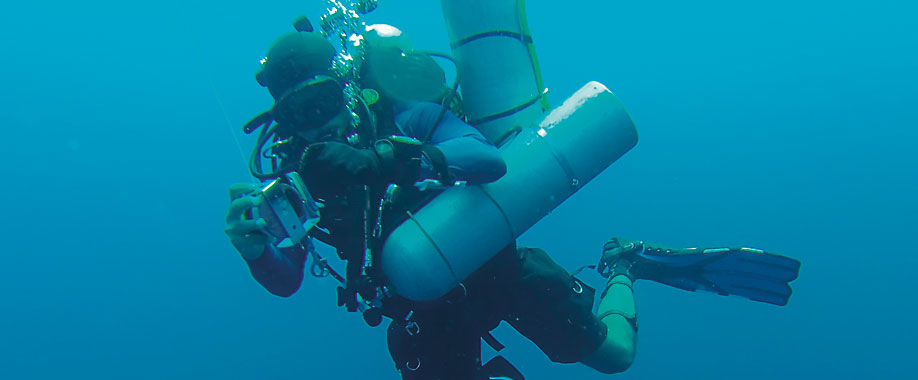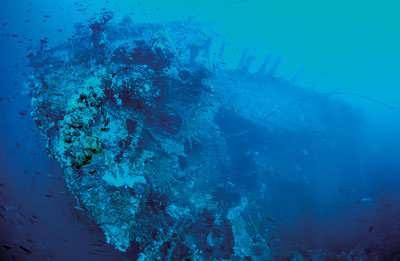Searching the deep blue…
Darshana Jayawardena speaks to Smriti Daniel about his almost spiritual experience of coming face to face with the S.S Worcestershire
When scanning the ocean floor with basic sonar equipment, usually all Darshana Jayawardena will see is a straight line on his screen. Then abruptly, the line rises sharply, its vertical ascent indicating that there is now something looming below, something big. While it could be a rock, Darshana is betting it’s what he’s come looking for – a sunken ship just waiting to be discovered.

Darshana
There are an estimated 200 wrecks garlanding the island, some even dating back to WWI. 100 years at the bottom of the sea will change a ship, often beyond recognition. As a ship rusts and warps, her body shrinks under the weight of the water above.
Coral may begin to colonise her skeleton and soon she has a new silhouette which attracts new company – an entire eco-system develops around the ship-reef starting with juvenile fish who treat it as a nursery. To a diver, however, the wreck is a rich oasis of life on the seabed, a lost realm ready to be explored, a mystery waiting to be solved. Local conservationists argue our wrecks must be preserved – if not for their immense environmental value than at least for their historical interest and the tourists they lure to Sri Lankan shores.
Darshana however, had been keeping his eye out for one wreck in particular. The S.S Worcestershire was an armed British merchant ship which was en route from Rangoon to London in 1917 when she was taken down by the German mine layer SMS Wolf. “Wolf was something of a legend in Germany,” says Darshana, explaining the ship which was sent to Sri Lanka to destabilise the British regime ended the war with 35 ‘kills’ to her credit.
Setting out to find her, he had unearthed nothing but sand so far when a tip from a local fisherman brought him to a new wreck that looked particularly promising, one within a 5km radius from the last known location of the Worcestershire. Located 30km south west of Colombo port, it lay a challenging 60m deep.
Recalling his descent toward the ship, Darshana would later write: ‘as always, a first glimpse of a deep ship is bone chilling thrilling. As narcosis envelops your senses what seems to be a large and hazy shadow slowly develops details. Then, at 50 meters we are at the ship and in a strange, deep, lush paradise seen by few.’ The divers are enveloped by shoals of fish – Gray Snappers, Yellow Fin Trevally, Giant Trevally and Groupers swirl around the wreck. The dive, which he would undertake alone more often than not, demanded four tanks instead of just one.

Darshana on a dive
Identifying a ship from archival images is a tricky process – pictures can be very grainy. Typically divers look for things like distinctive weaponry or for the emergency bell that bears the name of the ship. The name might also be engraved somewhere in the engine room, but going into a wreck is a hazardous undertaking, one that has claimed many divers lives.
One of the safer ways is to measure the ship and see how it compares to records. When Darshana measured the width of the Worcestershire’s beam, he found it matched nearly perfectly. Then he found even more conclusive proof – on a 100 minute long dive he discovered a pot at 53.4m with the inscription ‘Bibby Line.’
The significance was immediately obvious – established in 1821, Bibby Line owned the S.S. Worcestershire and it was the only of ship of theirs known to have sunk in the vicinity of Sri Lanka. Much to his amusement, Darshana would later discover that the object he’d found was actually a chamber pot. (The Bibby Line connection is also interesting for its relationship to another great wreck – that of the Titanic. The Worcestershire was built in the same shipyard as the Titanic and was also registered in Liverpool.)
Going forward, Darshana will likely be back to dive down to the Worcestershire many times. For every 20 minutes he spends exploring the wreck, he will spend another 70 in decompression as he rises ever so gradually to the surface. For Darshana, the years spent hunting and the hours he dedicates to each trip is absolutely worth it: encountering a wreck, he says, is almost a spiritual experience and one he wouldn’t want to do without.

Wreck of the S.S Worcestershire
Follow @timesonlinelk
comments powered by Disqus


